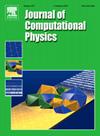A review of low-rank methods for time-dependent kinetic simulations
IF 3.8
2区 物理与天体物理
Q2 COMPUTER SCIENCE, INTERDISCIPLINARY APPLICATIONS
引用次数: 0
Abstract
Time-dependent kinetic models are ubiquitous in computational science and engineering. The underlying integro-differential equations in these models are high-dimensional, comprised of a six–dimensional phase space, making simulations of such phenomena extremely expensive. In this article we demonstrate that in many situations, the solution to kinetics problems lives on a low dimensional manifold that can be described by a low-rank matrix or tensor approximation. We then review the recent development of so-called low-rank methods that evolve the solution on this manifold. The two classes of methods we review are the dynamical low-rank (DLR) method, which derives differential equations for the low-rank factors, and a Step-and-Truncate (SAT) approach, which projects the solution onto the low-rank representation after each time step. Thorough discussions of time integrators, tensor decompositions, and method properties such as structure preservation and computational efficiency are included. We further show examples of low-rank methods as applied to particle transport and plasma dynamics.
时变动力学模拟的低秩方法综述
随时间变化的动力学模型在计算科学和工程中无处不在。这些模型中潜在的积分-微分方程是高维的,由六维相空间组成,使得这种现象的模拟非常昂贵。在本文中,我们证明了在许多情况下,动力学问题的解存在于可以用低秩矩阵或张量近似来描述的低维流形上。然后,我们回顾了所谓的低秩方法的最新发展,这些方法在这个流形上演化解。我们回顾的两类方法是动态低秩(DLR)方法,它推导出低秩因子的微分方程,以及逐步截断(SAT)方法,它在每个时间步长后将解投影到低秩表示上。深入讨论了时间积分器,张量分解和方法性质,如结构保存和计算效率。我们进一步展示了应用于粒子输运和等离子体动力学的低秩方法的例子。
本文章由计算机程序翻译,如有差异,请以英文原文为准。
求助全文
约1分钟内获得全文
求助全文
来源期刊

Journal of Computational Physics
物理-计算机:跨学科应用
CiteScore
7.60
自引率
14.60%
发文量
763
审稿时长
5.8 months
期刊介绍:
Journal of Computational Physics thoroughly treats the computational aspects of physical problems, presenting techniques for the numerical solution of mathematical equations arising in all areas of physics. The journal seeks to emphasize methods that cross disciplinary boundaries.
The Journal of Computational Physics also publishes short notes of 4 pages or less (including figures, tables, and references but excluding title pages). Letters to the Editor commenting on articles already published in this Journal will also be considered. Neither notes nor letters should have an abstract.
 求助内容:
求助内容: 应助结果提醒方式:
应助结果提醒方式:


